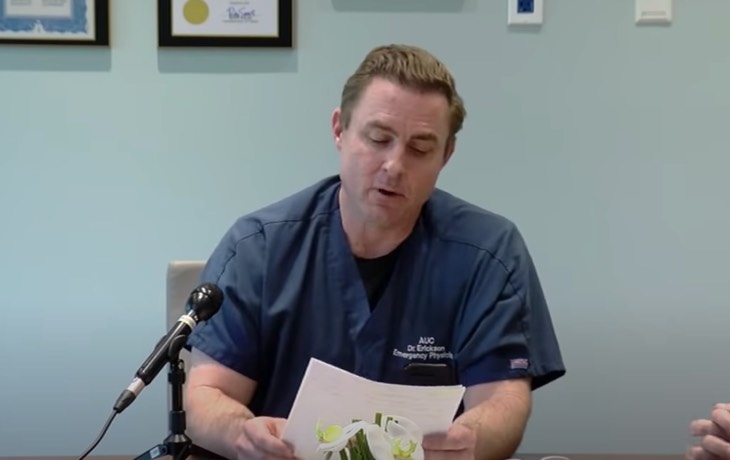In a viral YouTube video that many on our social feeds are citing as proof that the lockdowns were a costly mistake, a California osteopath named Daniel Erickson uses testing results from his chain of emergent care clinics to make the following familiar (and wrong) claim: we don’t have to worry about COVID-19 because it’s less dangerous than the seasonal flu.
But like most viral “science” videos on YouTube that aim to prove everything you know is a lie, the video doesn’t hold up to analysis. You’ll be dangerously misinformed if you buy what this clip is selling.
https://www.youtube.com/watch?v=xfLVxx_lBLU
Update: YouTube has taken the video down, and the American College of Emergency Physicians (ACEP) and the American Academy of Emergency Medicine (AAEM) have released a joint statement condemning the video as financially motivated and inaccurate.
A catalog of errors
Erickson is, in fact, a physician, although not an MD. He is not an infections disease expert, immunologist, epidemiologist, or researcher. He’s also not in active practice. But we must evaluate claims on their merits, and the argument presented in this video has no merits. It is complete bunk (to use a technical term).
The video, which is better browsed in transcript form, is a catalog of errors that range from the blatantly wrong to the subtly misleading. But the central and most inexcusable flaw of the entire video is this. Erickson confuses test positivity rates (i.e., the percentage of positive PCR tests among a group of people who were actually able to get tested for COVID-19) with community attack rates (i.e., the percentage of people in a whole population who have had COVID-19).
We’ll talk about why this distinction matters, but first let’s look at what Erickson said in the briefing:
So if you look at California—these numbers are from yesterday—we have 33,865 COVID cases, out of a total of 280,900 total tested. That’s 12% of Californians were positive for COVID. So we don’t, the initial — as you guys know, the initial models were woefully inaccurate. They predicted millions of cases of death — not of prevalence or incidence — but death. That is not materializing. What is materializing is, in the state of California is 12% positives. You have a 0.03 chance of dying from COVID in the state of California.
Here’s the obvious reason why using a 12% test positivity rate to claim that 12% of Californians already have SARS-COV-2 is so dangerous. Right now, the USA and many other countries are limiting their testing only to people who show symptoms of COVID-19. Furthermore, in many parts of the country since this all began, only those with the most severe COVID-19 symptoms have been tested. We aren’t testing 100% of the population.
What Erickson does in this video is conceptually the same as sampling a communion line to figure out how many Catholics live in California. Or estimating the prevalence of alcoholism by sampling an AA meeting.
It may be hard to believe that a physician would do something so dumb, but that’s exactly what he’s up to in this clip.
As if to remove any doubt that he really is doing this, Erickson goes on to make the exact same flawed argument with numbers from New York, the USA as a whole, Sweden, and Norway. This obvious mistake is central to his entire argument in the video.
A closer look at test positivity rates in the US
The story is different in Iceland and a few other countries with effective mass-testing programs. But in the United States, the tested population is very different from the general population. The tested population is much more likely to have COVID-19 than the larger community. In practice, that means the test positive rate actually shrinks as the disease spreads and health officials relax the testing criteria.
For example, test positivity is currently at about 8% in hard-hit Washington State. In barely-hit Puerto Rico, though, test positivity is 12%. Why the backwards numbers? To start, Washington State has about four times as many deaths per capita as Puerto Rico. Because Washington has been hit so much harder, they’re casting a far wider net with their testing program.
For another example, consider trends over time. In the state of Washington, test positivity was at 100% until March 5. The next day, test positivity fell to 30%. Ten days later, it was 10%. And it’s been hovering around 8% ever since. Washington, like most other places, started by testing only those with severe COVID-19 symptoms and a travel history that suggested exposure. But in the end, the state expanded the testing program and got a lower rate of positives.
Garbage in, garbage out
So, sure, Erickson misunderstands critical epidemiological concepts like test positivity and attack rate. But he also reaches conclusions that are totally at odds with the rest of his data.
For starters, Erickson claims COVID-19 has a lower fatality rate than the seasonal flu. Well, this season flu’s CFR is about .1%. By now, however, .2% of the entire population of New York City has died of COVID-19.
Even if we take the highest responsible data-based estimates from any source, only about 20% of the New York City population has tested positive for COVID-19. The positive rate might actually be much lower than that since that study sampled people in public spaces. That method has bias problems of its own. The virus hasn’t stopped spreading in New York City, so the fatality rate will almost certainly rise as the positive rate falls.
Let’s step away from the nonsense Erickson is pushing and go back to the real data. The latest serostudies and the most recent case and mortality data indicate the same thing we’ve seen, in broad strokes, since we first covered this topic in January. The fatality rate of COVID-19 is much higher than the seasonal flu and somewhat lower than SARS. If it runs rampant through the United States and infects most of the population, the death toll will be much higher than any seasonal flu in history.
If someone on your social media feed shares this video, please pass this article along. Everyone should have a chance to understand what’s wrong with its claims and conclusions.


You are reporting the comment """ by on